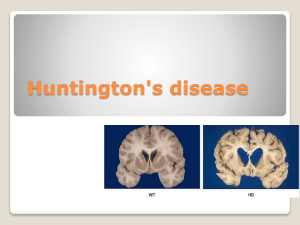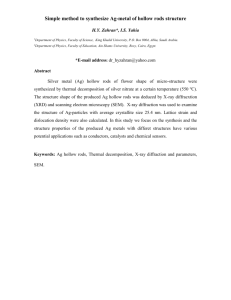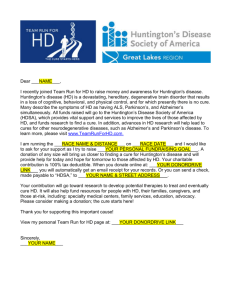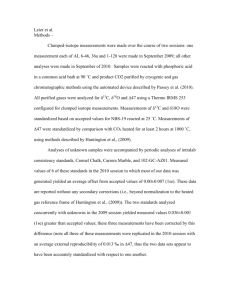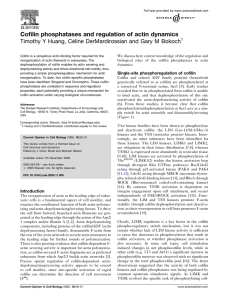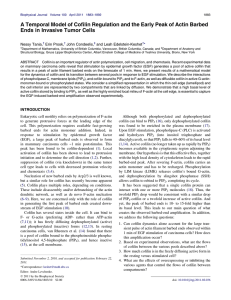Jaclyn Nguyen Term Paper
advertisement
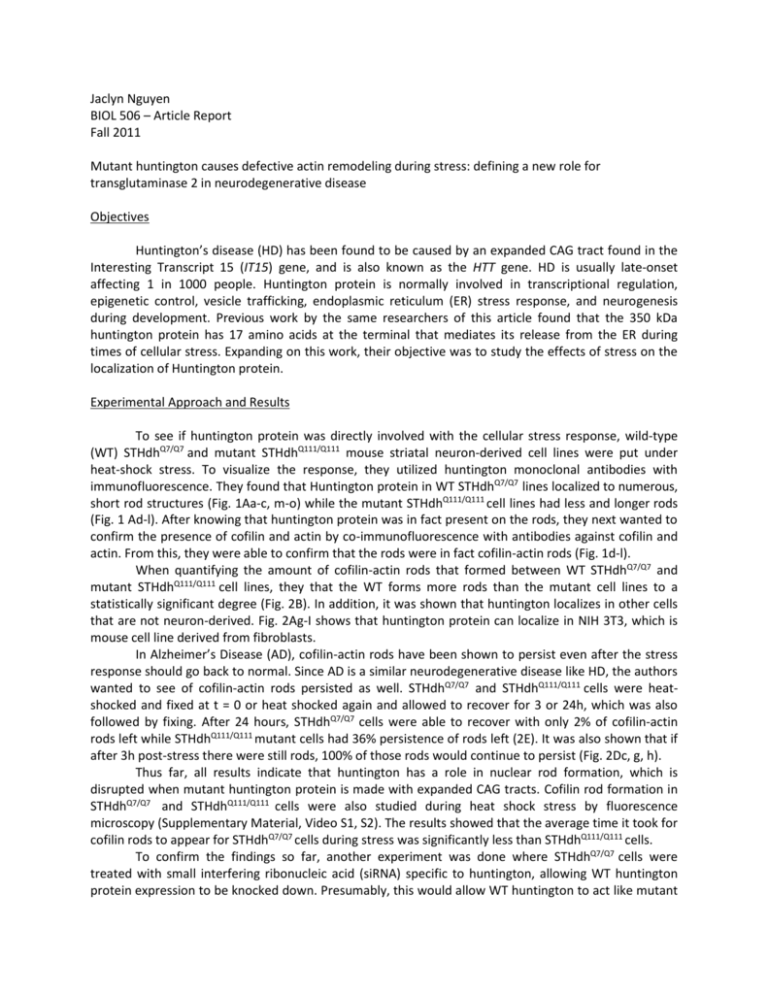
Jaclyn Nguyen BIOL 506 – Article Report Fall 2011 Mutant huntington causes defective actin remodeling during stress: defining a new role for transglutaminase 2 in neurodegenerative disease Objectives Huntington’s disease (HD) has been found to be caused by an expanded CAG tract found in the Interesting Transcript 15 (IT15) gene, and is also known as the HTT gene. HD is usually late-onset affecting 1 in 1000 people. Huntington protein is normally involved in transcriptional regulation, epigenetic control, vesicle trafficking, endoplasmic reticulum (ER) stress response, and neurogenesis during development. Previous work by the same researchers of this article found that the 350 kDa huntington protein has 17 amino acids at the terminal that mediates its release from the ER during times of cellular stress. Expanding on this work, their objective was to study the effects of stress on the localization of Huntington protein. Experimental Approach and Results To see if huntington protein was directly involved with the cellular stress response, wild-type (WT) STHdhQ7/Q7 and mutant STHdhQ111/Q111 mouse striatal neuron-derived cell lines were put under heat-shock stress. To visualize the response, they utilized huntington monoclonal antibodies with immunofluorescence. They found that Huntington protein in WT STHdhQ7/Q7 lines localized to numerous, short rod structures (Fig. 1Aa-c, m-o) while the mutant STHdhQ111/Q111 cell lines had less and longer rods (Fig. 1 Ad-l). After knowing that huntington protein was in fact present on the rods, they next wanted to confirm the presence of cofilin and actin by co-immunofluorescence with antibodies against cofilin and actin. From this, they were able to confirm that the rods were in fact cofilin-actin rods (Fig. 1d-l). When quantifying the amount of cofilin-actin rods that formed between WT STHdhQ7/Q7 and mutant STHdhQ111/Q111 cell lines, they that the WT forms more rods than the mutant cell lines to a statistically significant degree (Fig. 2B). In addition, it was shown that huntington localizes in other cells that are not neuron-derived. Fig. 2Ag-I shows that huntington protein can localize in NIH 3T3, which is mouse cell line derived from fibroblasts. In Alzheimer’s Disease (AD), cofilin-actin rods have been shown to persist even after the stress response should go back to normal. Since AD is a similar neurodegenerative disease like HD, the authors wanted to see of cofilin-actin rods persisted as well. STHdhQ7/Q7 and STHdhQ111/Q111 cells were heatshocked and fixed at t = 0 or heat shocked again and allowed to recover for 3 or 24h, which was also followed by fixing. After 24 hours, STHdhQ7/Q7 cells were able to recover with only 2% of cofilin-actin rods left while STHdhQ111/Q111 mutant cells had 36% persistence of rods left (2E). It was also shown that if after 3h post-stress there were still rods, 100% of those rods would continue to persist (Fig. 2Dc, g, h). Thus far, all results indicate that huntington has a role in nuclear rod formation, which is disrupted when mutant huntington protein is made with expanded CAG tracts. Cofilin rod formation in STHdhQ7/Q7 and STHdhQ111/Q111 cells were also studied during heat shock stress by fluorescence microscopy (Supplementary Material, Video S1, S2). The results showed that the average time it took for cofilin rods to appear for STHdhQ7/Q7 cells during stress was significantly less than STHdhQ111/Q111 cells. To confirm the findings so far, another experiment was done where STHdhQ7/Q7 cells were treated with small interfering ribonucleic acid (siRNA) specific to huntington, allowing WT huntington protein expression to be knocked down. Presumably, this would allow WT huntington to act like mutant STHdhQ111/Q111 cells due to siRNA interfering with STHdhQ7/Q7 cell’s appropriate expression of the huntington protein. In fact, this was proven to be true during a similar fluorescence microscopy assay filming the formation of cofilin rods in WT STHdhQ7/Q7 with control siRNA and STHdhQ7/Q7 cells that were treated with huntington specific siRNA. STHdhQ7/Q7 that were treated with huntington specific siRNA had delayed rod formation as well as persistence of rods post-stress, mimicking what was seen in STHdhQ111/Q111 cells (Fig. 4D; Supplementary Materials, Video S3, S4). Additional experiments were performed to see if there was a difference in cofilin levels at different stages of HD. Cofilin from lymphocytes sample from HD patients at different stages of the disease were western blotted. It was then observed that as the disease advanced, cofilin complexes gradually increased in size (Fig. 5A). They also blotted for actin and saw that it was also migrating with the cofilin samples (Fig 5A). As such, these complexes were actually cofilin-actin complexes. They compared the ratio of cofilin-actin complex (higher order band) to free cofilin (lower order band) and found that complexing was statistically significant compared to free cofilin in cells as HD severity increased (Fig. 5B). Due to the results of the previous experiment where cofilin-actin complexes were seen to increase along with HD progression, it was questioned what exactly was involved with the cross-linkage between cofilin and actin. Previous research has shown that Tissue transglutaminase (TG2) was involved in the cross-linking of actin and cofilin when it was added to the cells. TG2 in itself has multiple functions, including forming covalent bonds between polypeptide-bound lysine and polypeptide-bound glutamine. TG2 has also been shown in other studies to have increased activity in HD patient lymphocytes. With these results in mind, the researchers looked at TG2 as the link between cofilin-actin complexing. Experiments were done to see if TG2 activity could be seen in the rods of the STHdh system. To measure the activity, FILM was used to analyze the fluorescence lifetime of donor fluorophore (mCerulean blue cyan fluorescent protein [CFP]—cofilin donor) to FRET efficiency in the presence of an acceptor eYFP (TG2). This technique will determine if two proteins interact with each other within 8 nm in vivo. As such, this made for a good technique to measure the interaction of cofilin and TG2. It was seen that in steady state conditions, mCerulean—cofilin was visible with eYFP (Fig. 6Aa-c) or eYFP—TG2 (Fig. 6Ad-f), which means that there was no interaction. After heat shock, the lifetime of mCerulean— cofilin was shorter since FRET was in the presence of eYFP-TG2 (Fig. 6Ak-r). This meant that there was interaction between cofilin and TG2, indicated by the yellow-orange color. These data confirm that TG2 may in fact be involved with the cross-linking between cofilin and actin. To see if TG2 was the catalyze for cross-linking actin and cofilin, the presence of cofilin-actin complex was analyze on a western blot with STHdh cells that were in steady state, heat shocked, in a state for TG2 was over-expressed, and heat shock with TG2 over-expressed. The migration of the cofilinactin band was only seen when cells were under heat shock with TG2 over-expressed (Fig. 6C). In a control using samples from an HD patient at a late stage of the disease showed a clearer band, suggesting that there is chronic stress in the lymphocyte cells instead of transient stress as they have done in their model of the disease. Conclusion Previous work has shown that huntington protein has the ability to come off the ER and localize in the nucleus in response to cellular stress. These authors of shown that huntington has the ability to affect nuclear actin remodeling during heat shock stress response. Huntington protein localizes on cofilin-actin rods during stress, which form to stop actin treadmilling thereby freeing up ATP to be used in other parts of the cell to respond to the stress. During the proper response, short and numerous amounts of cofilin-actin rods with associated huntington protein will be formed. In the presence of mutant huntington protein, the cellular response was impaired. In these cells, the cofilin-actin rod formation was to a lesser degree and they were shorter. In addition, they continued to persist after the stress response was no longer needed. As these rods persist, it takes up most of the free cofilin for when it is needed during actin remodeling. Maintaining plasticity of dendritic spines is crucial for projection neurons of dendritic spines, which is regulated by actin turnover. There is also high ATP demand in a steady state cell during actin remodeling activities. The formation of few and longer rod structures with mutant huntington allows less ATP to be freed up and its persistence does not allow actin remodeling to resume. In turn, this would all easily cause neurodegeneration that is seen not only in Huntington’s Disease, but also Parkinson’s and Alzheimer’s Diseases. Transglutaminase (TG2) was shown to be involved with the cross-linking of cofilin and actin. TG2 has been shown to be regulated by calcium levels. High Ca levels are a feature of cellular stress response, and it also up regulates TG2 activity. Based on this, there is potential therapy for either inhibiting TG2 enzymatic activity to prevent high amounts of cofilin-actin complexing in HD patients. Since the pathway of mutant huntington stress response is modeled, another therapeutic potential is manipulating the pathway by either interfering with the mutant protein’s interaction or overriding the impaired stress response pathway. Future Research Previous research has shown that Rho-associated kinase (ROCK) inhibitor, which is an upstream modulator of cofilin, has had beneficial effects in HD model systems. ROCK inhibition allows reduced phosphorylation of cofilin which then increases its binding to actin activity. Future research should perform ROCK inhibition using the STHdh cell line model system to see if it can reverse the effects of mutant STHdhQ111/Q111 cells. Future research should also focus on the TG2 pathway that was found in this paper. Experiments should include possibly controlling the levels of calcium since it has been shown to activate TG2 at high levels. Perhaps there is a way to decrease the calcium levels or inhibit its activity with calcium binding substrates. In response to the experiments, I think the authors could have done additional experiments showing how exactly how huntington protein associates with cofilin-acting rods. They did a nice job of showing that there is in fact a direct contribution of huntington protein to the successful formation of these rods, but they did not go into details or discuss why this may be. The beginning of the paper focused on experiments related to mutant huntington protein’s effects on the cellular response, and then jump to focusing on cofilin-actin rods. In the future, experiments should also include defining out how huntington protein localizes in the nucleus during a cellular stress response. More of the experiments could have also included more use of HD patient cells. I would have liked to see the researchers do immunofluorescence assays on HD patient cells to see if there was a difference between the mutant rods formed in the STHdh cell line models and real HD rods. Citation Munsie, L., Caron, N., Atwal, R. S., Marsden, I., Wild, E. J., Bamburg, J. R., et al. (2011). Mutant huntingtin causes defective actin remodeling during stress: defining a new role for transglutaminase 2 in neurodegenerative disease. Human Molecular Genetics, 20(10), 19371951.




